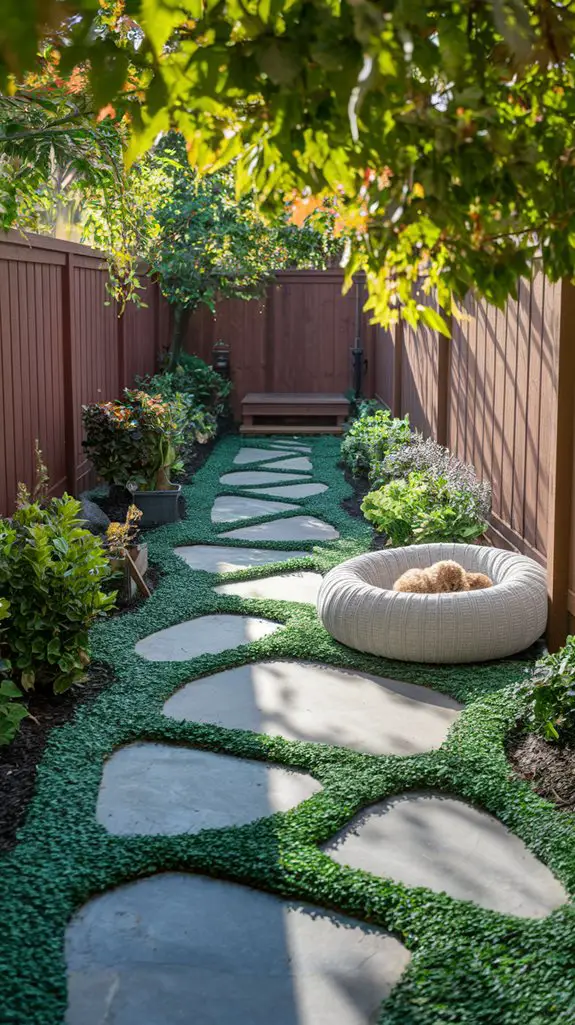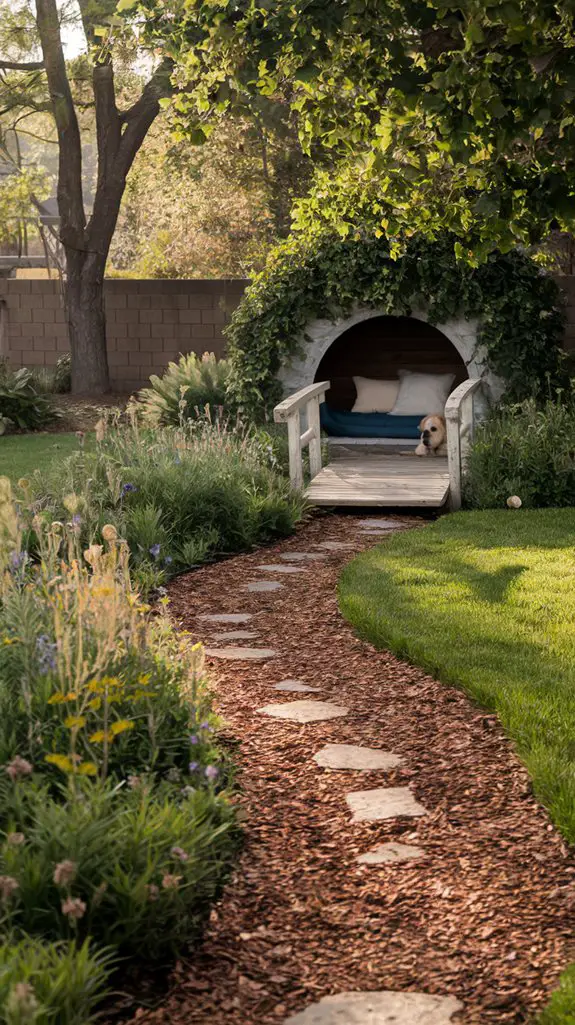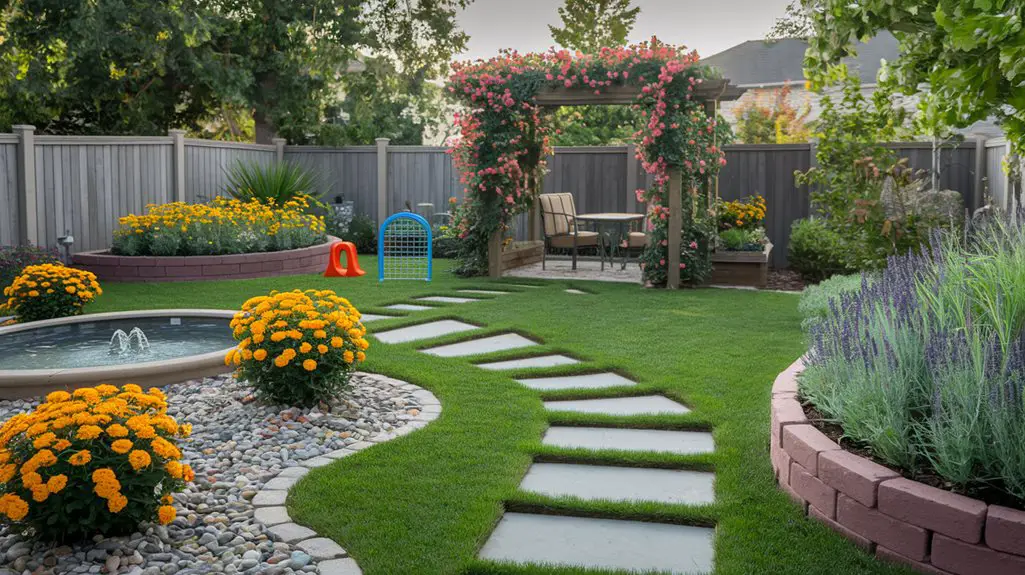Imagine your dog bounding across your backyard, paws skimming along a pathway designed just for them. You’ve invested in a beautiful outdoor space, but without proper pathways, your pet can damage plants, track mud inside, or even injure themselves on uneven terrain. Creating pet-friendly paths not only enhances your yard’s appearance but also provides safe routes for your four-legged companions to explore. The right materials can make all the difference for their comfort and your maintenance routine.
Paw-Friendly Gravel Paths: Comfort for Sensitive Feet
While traditional gravel can irritate your dog’s paw pads, properly selected paw-friendly gravel creates accessible pathways that both you and your pets will appreciate.
Opt for rounded pea gravel (3/8″ diameter) or decomposed granite with stabilizers to minimize sharp edges and shifting underfoot.
Install your pet-friendly path with a 2-3″ depth over landscape fabric to prevent weed growth and soil mixing. Create borders using pressure-treated lumber or stone edging to contain the material and define your pathway’s boundaries.
For ideal comfort, compact the gravel thoroughly during installation and maintain a smooth surface by raking periodically.
Consider incorporating stepping stones at regular intervals for enhanced stability. In high-traffic areas, select resin-bound gravel systems that provide superior durability while maintaining porosity for drainage—a vital feature for both yard health and paw comfort. Additionally, using pet-friendly materials in your yard design can enhance the overall safety and enjoyment for your furry friends.
Flagstone Walkways With Pet-Safe Ground Cover

Flagstone walkways provide a natural complement to paw-friendly gravel paths, offering solid footing with rustic appeal that benefits both pets and their owners.
Space stones 1-3 inches apart to accommodate low-growing, pet-safe ground covers like creeping thyme, Irish moss, or sedum. These plants withstand moderate traffic while softening the pathway’s appearance.
When selecting flagstones, opt for flat pieces with non-slip surfaces to prevent paw injuries and guarantee stability during wet conditions.
Install them at grade level to eliminate trip hazards for both humans and animals. Embed each stone firmly in a sand-gravel base to prevent shifting.
For areas with heavy pet traffic, consider corsican mint or woolly thyme between stones—these aromatic varieties release pleasant scents when brushed against and resist damage from occasional digging attempts by curious pets. Additionally, incorporating wildlife-friendly plants can enhance the overall ecosystem of your garden while supporting local fauna.
Mulch Trails: Natural and Gentle on Paws

When designing pathways specifically for pets, mulch trails offer a natural alternative that’s exceptionally gentle on sensitive paws while complementing your garden’s organic aesthetic.
Select cedar or cypress mulch for their natural pest-repellent properties, avoiding cocoa mulch which contains theobromine—toxic to dogs and cats.
Install edging to contain the mulch and prevent scatter. A depth of 2-3 inches provides cushioning while allowing proper drainage.
Consider incorporating landscape fabric beneath to suppress weeds without chemical herbicides that might harm your pets.
Replace mulch annually to maintain its softness and prevent decomposition issues.
In high-traffic areas, choose larger mulch chips that resist compaction and create a more stable surface for energetic pets.
The natural scent and texture will appeal to your animals’ sensory experience while providing safe, comfortable navigation. Additionally, using mulch can deter natural pests that might otherwise invade your garden space.
Stepping Stones With Resilient Grass Gaps
For pet-friendly pathways that balance aesthetics with durability, stepping stones spaced with resilient grass gaps offer an ideal compromise.
Select stones with non-slip surfaces placed 2-3 inches above soil level to prevent paw injuries while creating visual rhythm throughout your yard.
Choose drought-resistant, foot-traffic-tolerant grass varieties like fescue or Kentucky bluegrass for the gaps. These withstand both pet traffic and occasional urine spots without developing bare patches.
Install stones at least 18-24 inches apart to allow proper grass establishment between them.
Maintain this pathway system by trimming grass between stones regularly, keeping heights at 2-3 inches to prevent stones from disappearing visually while still providing cushioning for paws.
This design creates safe, intentional travel routes for pets while preserving your landscape’s coherent design aesthetic. Additionally, incorporating pet-friendly materials ensures the pathway remains safe and sustainable for your furry friends.
Raised Cedar Boardwalks for Wet Areas
In areas where seasonal flooding or persistent moisture creates muddy zones unsafe for pet exploration, raised cedar boardwalks offer an elegant solution that elevates the yard’s functionality. These structures keep paws dry while providing a defined path through problematic terrain.
When designing your boardwalk, select naturally rot-resistant cedar planks at least 1″ thick, spaced 1/8″ apart for proper drainage. Install the walkway 6-8″ above grade, supported by pressure-treated posts anchored in concrete footings.
Incorporate 1″ galvanized hardware cloth beneath the structure to prevent smaller pets from accessing the underneath space. For enhanced traction, position boards perpendicular to the walking direction and sand edges to prevent splinters.
Add low railings for elderly pets and integrate solar-powered edge lighting to improve visibility during evening bathroom breaks. Additionally, ensure that the boardwalk’s design considers privacy fencing styles to create a safe and secure environment for your pets.
Rubber Mulch Pathways: Durable and Non-Toxic
Rubber mulch pathways complement cedar boardwalks by offering similar paw-friendly benefits in less saturated areas of your yard. Made from recycled tires, these pathways provide cushioning for sensitive paws while remaining durable against scratching and digging behaviors. You’ll find they maintain their appearance for years, unlike organic mulches that decompose quickly. Additionally, they can help create shade solutions for your pet-friendly backyard, enhancing your pet’s comfort during outdoor playtime.
| Feature | Benefit |
|---|---|
| Non-toxic material | Safe if accidentally ingested |
| Shock-absorbing | Reduces joint impact for older pets |
| Doesn’t attract pests | Eliminates insect harborage issues |
| UV-resistant | Won’t fade or deteriorate in sunlight |
Install rubber mulch at a 2-inch depth minimum for proper cushioning. Create defined borders using plastic, metal, or stone edging to prevent scattering. For maximum effectiveness, place a weed barrier underneath to eliminate unwanted vegetation while maintaining proper drainage throughout your pathway system.
Artificial Turf Tracks: Clean Paws Year-Round
While natural grass areas can become muddy during wet seasons, artificial turf tracks provide dedicated pathways that keep your pet’s paws consistently clean throughout the year.
These synthetic routes offer excellent drainage capabilities, allowing rainwater to pass through rather than forming muddy puddles.
Install artificial turf in high-traffic zones where your pets regularly travel.
Select pet-specific turf varieties with antimicrobial properties that resist bacteria growth and odor absorption.
The ideal installation includes a properly excavated base with crushed stone for drainage, topped with a weed barrier before laying the turf.
For maximum functionality, create curved paths that follow your pet’s natural movement patterns through the yard.
You’ll appreciate the reduced indoor cleaning and your pets will enjoy consistent traction regardless of weather conditions. Additionally, low-maintenance solutions like artificial turf can significantly enhance the overall functionality of your yard for both pets and owners alike.
Conclusion
Your backyard’s pathways aren’t merely aesthetic choices—they’re critical infrastructure in your pet’s ecosystem. You’ve now mastered the precise technical specifications for seven different paw-transit systems, each engineered with meticulous attention to durability coefficients and comfort metrics. Congratulations on your impending shift from mere homeowner to pet-landscape architect. Your dog will surely appreciate your functional planning, even as they systematically destroy everything else you’ve planted.




